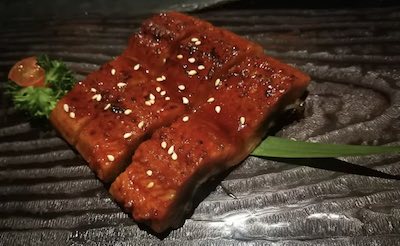We are reader supported. When you purchase through links on our site, we may earn an affiliate commission. Also, as an Amazon affiliate, we earn from qualifying purchases.
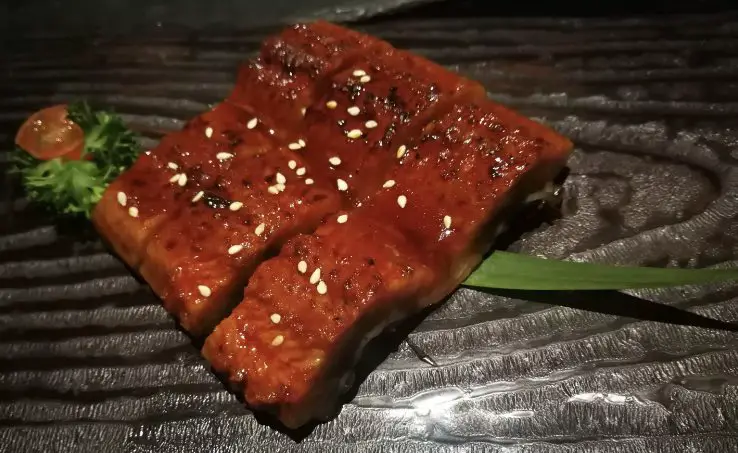
If you haven’t eaten freshwater or seawater eel before, it may make you go ‘ewww’ with its slimy appearance. However, if you have tasted it in some Japanese cuisine then you probably know how good it tastes. In fact, eel is rarely served raw and the pieces are usually steamed or marinated in some way before being used.
So, what are unagi and anago? They are both eels used in Japanese culture and cuisine for thousands of years. Unagi is freshwater eel, known for its bold and rich flavor. Anagi, on the other hand, is seawater eel, characterized by its naturally sweet taste and soft texture.
Despite belonging to the same family of fish, there are several differences between unagi and anago that I will tell you in this article. Let’s start by discovering them in detail one by one, and then move on to the differences.
Unagi (The Freshwater eel)
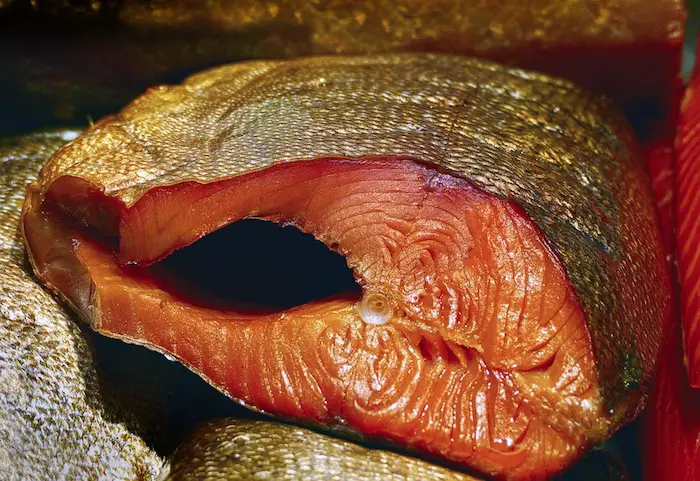
Unagi is a much sought after delicacy in Japan, especially during the hot summer days when you can find restaurants using them in almost every delicacy. As a result of this popularity, the population of freshwater eel has suffered significantly in the last few years.
Unagi is full of essential nutrients which may be a reason for it becoming a popular food to enjoy during the scorching midsummer. It is a popular tradition in Japan to eat unagi in the ‘Day of the Ox’ to gain strength to face the coming days.
As per the ancient traditions and interesting legends, Unagi is often considered as a strong aphrodisiac food that can increase the desire for sex. The folklores have it that if someone treats you with Unagi then probably the person has feelings for you and other intentions other than just serving food to you.
Unagi is usually served with a bowl of steaming rice to taste best and bring out its distinct flavors. The fish is rarely eaten raw and is mostly used in cooked variations. After the eel is filleted and de-boned, it is kept in an open flame grill to melt the fat underneath the skin.
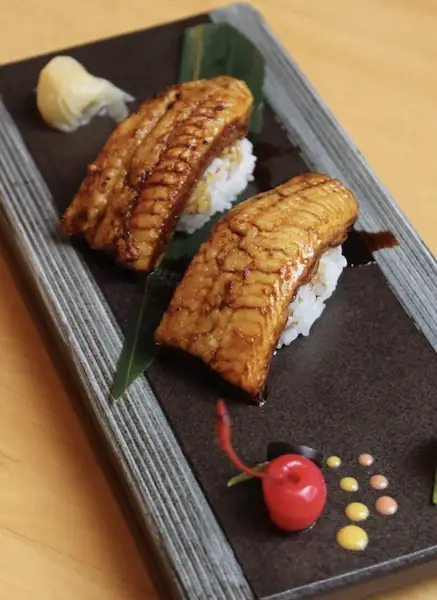
After the meat is grilled, it may be steamed, drained of the fatty oil and then basted in the savory eel sauce. The fish is grilled again to ensure that the sauce gets into it to enhance the flavor. It is often eaten as sashimi. While you can use it in your sushi rolls, people prefer to eat it in a charishi bowl.
If you would like to add unagi to your sushi roll, pair it up with crunchy cucumber and other vegetables to subdue its strong flavor. Here’s a quick recipe to help you make your own unagi sushi roll at home for dinner.
Unagi (Eel) Sushi Roll Recipe
Ingredients
• 3 cups seasoned and cooked sushi rice
• 4 to 5 Nori sheets
• 1 frozen vacuumed unagi
• 1 cucumber
• 1 avocado
• 1 red bell pepper
• Wasabi and soy sauce
Start by making sushi rice at least 30minutes before you plan to eat dinner. To find step by step instruction on how to cook sushi rice in a pot or cooker, and season it perfectly, read this article.
Take out the frozen unagi and cook it according to the instructions provided in the package. Once cooked, cut it into thin strips.
Wash a Japanese cucumber and cut it into thin match stick size strips. You may also use Persian or American cucumbers as they have fewer seeds.
Cut the avocado, remove the pit and scoop out the flesh using a spoon. Now, take half of the avocado and cut it into thin slices
Take half of the red bell pepper and cut it into thin strips to add some color to your unagi sushi roll.
Place the bamboo mat like this on the working table and keep the nori sheet on it, rough side facing upwards.
Now, take a medium ball of sushi rice and spread it on the Nori, keeping a thin gap on the edges.
Arrange the fillings by first placing the cucumber strips to cover the length of nori. Place the cooked unagi strips over cucumber and avocado slices beside it. Place a few red bell pepper strips over eel.
Now lift the bamboo mat close to you and start rolling. Press gently as you roll to ensure that you get a compact and cylindrical roll.
Seal the edges when you reach the end. Moisten the knife blade and cut the sushi roll into 6-8 pieces. The creamy texture and bold flavor of unagi are perfectly balanced by cucumber, pepper, and avocado.
Serve with wasabi, soya sauce and follow up with green tea. That’s my perfect recipe to enjoy restaurant-like sushi.
Anago (saltwater eel)
Sushi beginners often mistake anago with unagi, which is its freshwater counterpart. Although they both belong to the eel family, there’s a lot of difference between the two. Just like unagi, anago is also never consumed raw in sushi.
Anago has an elongated shape and they are mostly found in saltwater. These muscular fish are snake-like in their movement and can get into any services. They are nocturnal in habitat so they sleep during the day and feed on small fishes and crustaceans during the night.
They are usually cooked and prepared by simmering in a broth that takes a lot of time. At the time of serving, the broth may be brushed over nigirizushi to enhance the taste. The broth (tsume) here substitutes soy sauce so the sushi has a sweet and savory flavor.
As anago is always cooked before serving, it usually tastes very much like barbecued fish. When served in the form of nigiri, it is often slightly bigger than other varieties and can be a highly filling meal. Although it is not as fatty as the freshwater eel, it is still considered as a fatty fish.
At the time of simmering, the fat usually breaks down so that the meat becomes mushy and fluffier than unagi, which has a chewy texture. The tsume eel sauce caused by the reduction of broth turn into gelatin after a long period of simmering.
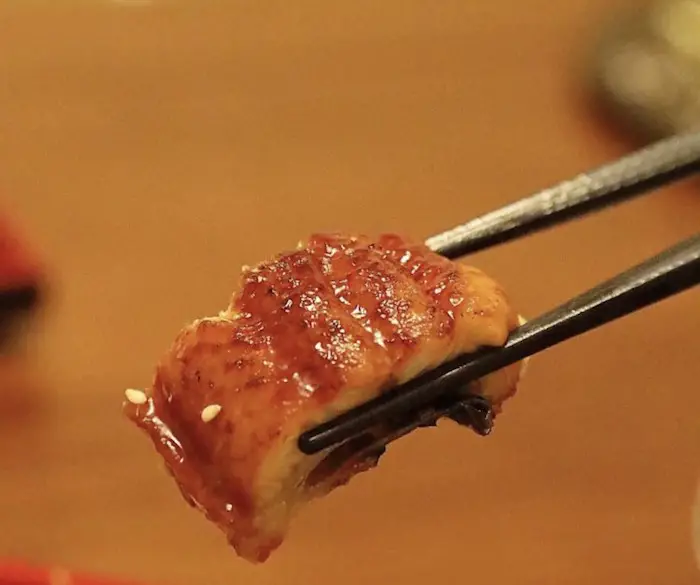
At times, anago may be grilled before being used in sushi but the extensive methods are mostly used for unagi. Preparing anago is a comparatively simpler process and the master chef often cooks several eels in the same sauce.
At the time of simmering the anago eel, the chef often uses an otoshibuta cypress lid that floats on water and helps in keeping the eels properly submerged. It also avoids too much evaporation and prevents the bubbles from shredding the meat apart.
Anago Nigiri Sushi
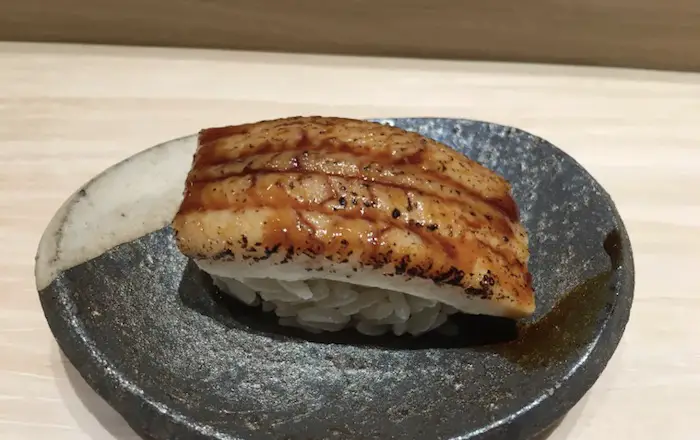
Anago is often referred to as the underdog or underrated eel because its counterpart unagi got away with all the limelight and popularity. While most people know unagi as the popular choice for sushi and most of the restaurants also focus on that variety, anago is also very delicious.
So, here’s an anago recipe for you. I asked my chef friend for instructions and listed them down here to help you prepare the anago fillets at home. I agree that they are slimy but if you can deal with that, the end result turns out to be delicious.
Ingredients
• Anago fish fillets
• Cooked sushi rice
• Sake
• Soy sauce
• Sugar
• Water
• Nori strips
Preparing eel is a smelly process and only an experienced chef can do it correctly. They usually have a special spike like tool called me-uchibo that is used to hold the head in place and split open the body lengthwise.
If you are planning to make anago sushi at home, ask the fishmonger to cut the fish into fillets as they have the sharp knives required to handle eel’s slimy body.
Once you reach home, wash the pieces thoroughly and scrub them clean to remove the sliminess as much as you can.
In a large bowl prepare a solution of two parts sake, one part soy sauce, one part sugar, and one part water
Add a drop lid or ensure to ensure that the fillets stay submerged in the concoction and bring to boil. Cook for 15-20 mins.
When you are able to break the anago pieces using your chopstick, you may consider that it is well cooked.
The anago soaks up most of the juice to becomes flavorful. Make sure you lay them flat when they are still hot or else you won’t be able to straighten them after they cool down.
Now, take a medium ball of cooked and seasoned sushi rice in your hands and shape it up in an oval bed with a dent in the lower middle, resulting on a slight hump on the top. Find out how to make sushi rice here.
Cut out a slice of the cooked anago, long enough to cover the sushi rice completely. Use your fingers to form a bond between the neta (fish) and the rice. You may use a nori strip to hold them together.
You may apply some of the reduced sauce in the bowl to apply on the fish instead of soy sauce. Now, serve it with wasabi and enjoy.
Difference Between Unagi And Anago
Now, that we have learned about both these varieties of sea eel, let’s take a look into the major differences between the two. However, remember that they are both delicious and it’s a matter of choice. Let’s take a look at the differences from the point of origin to the table.
Unagi (freshwater eel) is commonly referred to as the Japanese eel that is also found in Korea, and other parts of China, Vietnam, and Taiwan. Anago (saltwater eel) on the other hand is called the conger eel, found in Japan.
In appearance, unagi is thick, black, fleshy and bigger in size than its counterpart anago, which is leaner and has a soft brown color.
Unagi has twice the fat content as compared to anago and the taste is richer and buttery. It usually has a soft texture. Unagi is often regarded as a superfood and contains more nutritional value than anago. It is often used as a summer food to increase the body’s stamina to fight away the sweltering heat.
Unagi is usually cooked in skewers and it is dipped in soy sauce several times during the process. It is then steamed and grilled until the exterior becomes dark brown and crisp. It is usually served over a bed of rice.
Anago is used as a topping on sushi or cooked in tempura style. When used as a topping in nigirizushi, it is never served raw but usually simmered in a sweet sauce to enhance the flavor.
When it comes to cost, unagi is slightly more expensive than anago. This is primarily because unagi is considered as a sought after delicacy and has more fat content than anago. In Japan, a bento box containing unagi over a bed or rice may cost between 3000 to 6000 Yen, while anago tendon may cost between 1000 to 2000 Yen.
| Unagi | Anago | |
| Nickname | Japanese eel | Conger eel |
| Origin | Found in Japan, Korea, China, Taiwan, Vietnam, and the northern Philippines. | Northwest Pacific, off the coasts of Japan |
| Lifecycle | Lays eggs in the sea and young ones migrate to rivers to mature | Spends the entire life in seawater |
| Taste | Rich and fatty taste | Slightly sweet with delicate flavors |
| Appearance | Drak gray or black outer skin | Light brown skin with white dots |
| Tail | Roundish in shape | Slightly pointy |
| Preparation | Mostly grilled to melt the fat | Simmered to soak the sauces |
| Served over steaming rice | Prepared as a sushi or roll | |
| Texture | Soft and fluffier | Dense and chewy |
Related Questions
Is eel in sushi raw?
No, it may surprise you but both unagi and anago are cooked thoroughly before being used in a recipe. They are usually cooked in sweet and savory sauces to enhance the flavor.
Is it safe to eat eel in pregnancy?
Yes, you may consume eel when you are expecting a baby but make sure you do in moderation. You must also make sure that the eel is thoroughly cooked. As both saltwater and freshwater eel are rich in nutrients, you will actually benefit from eating both.
What drink goes best with eel delicacies?
You can pair up Japanese sake with both unagi and anago delicacies to get the most of the umami flavors. Wines also beautifully complement the taste of eel.

